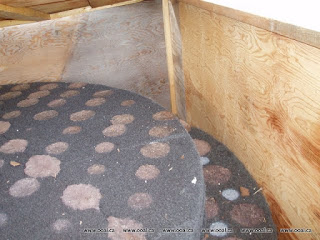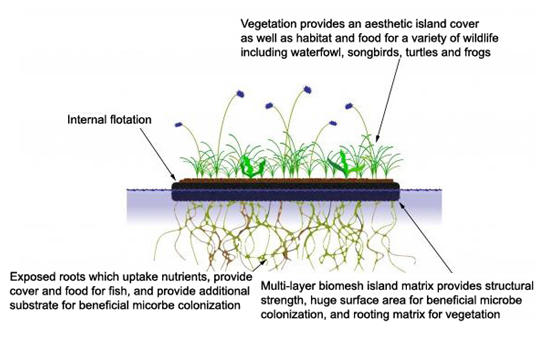I've had an interest in floating islands for awhile, but not much experience with them, just the odd sighting at places like Lonnie Poole GC at the North Carolina State University. I decided to contact Rob Cook of Floating Island Southeast in Chapel Hill NC to discuss with Turfhugger readers some of the benefits of these products, starting with how they can improve water quality.
The Biohaven™ Floating Wetland, manufactured and distributed by Floating Island Southeast in North Carolina, is made from 100% post consumer recycled plastic that serves as a platform for a wide variety of landscape plants that grow on top of the island and become a floating garden.
 |
| Students from Centennial Campus Magnet Middle School helped to build a “floating island” on the Lonnie Poole Golf Course |
Biohaven™ Floating Treatment wetlands is a new tool for golf course superintendents who are concerned about three things in their golf course ponds: water quality, overall appearance of the pond and minimizing maintenance costs. These days you really have to balance all three factors if you want to be successful at managing your golf course ponds, the course’s ponds need to be kept looking beautiful and budgets have to be managed in today’s tight economy. At the foundation of these two factors listed above is water quality, if water quality suffers the ponds are going to be growing algae and look poorly, or you can spend a lot of money cleaning the water with chemicals.
So if you can find a tool that will preserve water quality without a huge maintenance cost then you can keep your ponds looking good and not blow your maintenance budget. It so happens that the Biohaven Floating Treatment Wetland is just such a tool that can maintain water quality and not cause a huge hole in the maintenance budget and, to boot, it looks great.
The Biohaven™ Floating Wetland, manufactured and distributed by Floating Island Southeast in North Carolina, is made from 100% post consumer recycled plastic that serves as a platform for a wide variety of landscape plants that grow on top of the island and become a floating garden.
The choice of plants is pretty wide, it can be either native wetland plants or a horticultural planting scheme that is more formal. With any plant that is chosen the effect is the same, the plants grow on top of the island and send their roots down through the matrix and into the water.
With the plant roots creating a root curtain below theisland and creating carbon sources below the island and in the water the next step happens – microbes start to grow and algae starts to grow on the high surface area of the roots and the non-woven matrix of the island. Unlike some floating structures that contain plants, the Biohaven™ floating islands are designed to interact with the water column to clean it naturally. Very cool.
Here are a couple files I thought would be fitting to include.




1 Comments so far
I love this stuff
EmoticonEmoticon